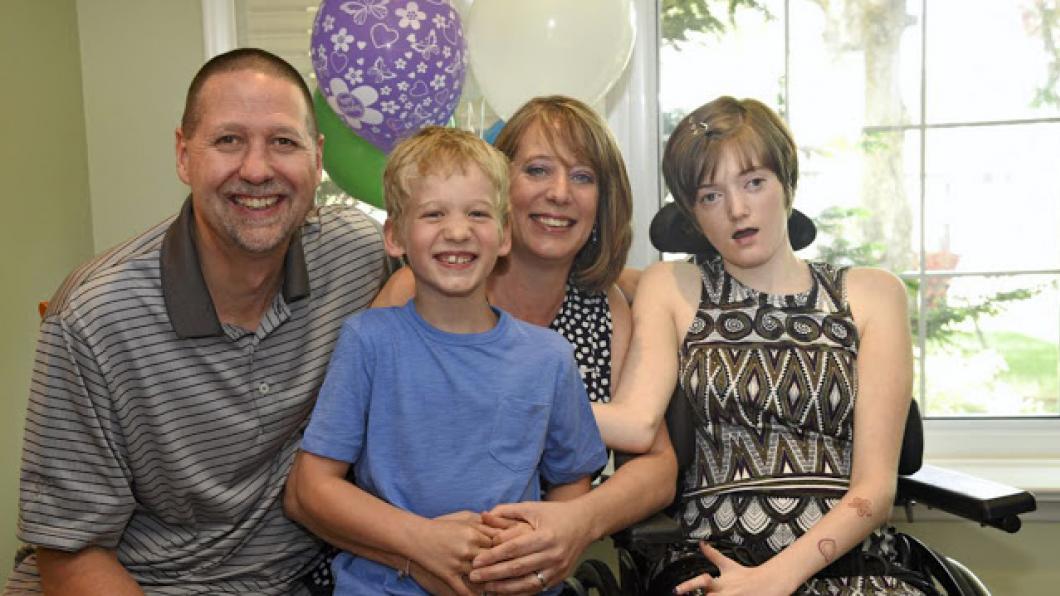
'Take care of yourself first:' A parent's recipe for mental health
By Louise Kinross
Studies show elevated rates of depression and anxiety in parents of children with disabilities. They even show our cells age faster due to high stress.
This week is Mental Health Week in Canada. The Canadian Mental Health Association is running a great campaign called '#GetLoud about what mental health really is.' It includes descriptors like 'It's about feeling good about who you are, having balance in your life, and managing life's highs and lows.'
The Centre for Mental Health and Addiction also has an excellent campaign. It's designed to remove stigma: 'My mental health is as important as my physical health.'
BLOOM is talking to parents to learn about what they do to care for their mental health.
First up is Laura Meffen. Laura’s daughter Emily Kerr, 19, has NGLY1—a neurological condition in which people lack an enzyme that helps the body remove proteins that aren’t working properly. She has complex disabilities and health needs.
Back in 2003, when Emily was five, Laura wrote a BLOOM piece about walking into a hospital emergency, suicidal, and being admitted for a major depression. At the time, she wrote, she felt she ‘had to live up to that super-mother image…My self-worth was tied to maintaining that image of perfection and doing everything myself.’
This year Emily, almost 20, moved into a full-time residence called Participation House. Here’s what Laura says she’d tell another parent of a child with complex needs about mental health:
“You need to put your family first, as opposed to one child. A lot of anxiety comes from wanting to do everything possible for our child with disabilities. We get wrapped up in physical therapy, occupational therapy, speech therapy, and then we hear about a parent who’s doing this other therapy, and another parent who's doing something different. You want to do everything, but you can’t. It’s impossible. And it’s okay to not do everything. It isn’t healthy, as a parent, to be focused on one child 24-7.
“I’m a big advocate of respite—no matter how you get it. When Emily was younger I hired a mother’s helper. At first, she would play with Emily and care for her while I was still in the house. Then, when I got confident with her, I might leave them and run out to the grocery store. But most often, I went upstairs to have a nap.
“I put Emily in respite at Safehaven when she was 13. It was hard dropping her off, because she would cry. I had to do it in small steps and stages—baby steps. The first time we just visited. The next time we came and dropped her off at dinner time, because her favourite thing was eating. Then we came back to get her in two hours. The next time she stayed over a night. After that she would go for weekends. And then finally we were able to leave her for one week.
“Emily is a homebody and she doesn’t like to leave, so when she recognized we were going to Safehaven, she would often start to cry. But I would call after I dropped her off and the staff would hold up the phone so I could hear her interacting. And I could hear she was having fun.
“Now, Emily is in full-time residence at Participation House, and it was because of our experience with respite that when she turned 18, we found out about Participation House.
“Until she moved, I didn’t realize how stressed I was having Emily in the house. It’s hard not having her here, but it is for my mental and physical health, and for my family. I had to look at what was best for the whole family, including Emily’s brother Tyler.
“It was when the mother of another boy Emily went to school with passed away that I realized I had to take care of myself and I had to take care of the whole family.
“A long time ago, another person told me ‘You need to take care of yourself first. And then, when you’re good, that will take care of your relationship with your spouse. And if that is good, it will trickle down to your children.’ As opposed to what we usually do—which is put our children first, then our spouse, and then ourselves.
“Because we had put Emily in respite since she was 13, when we moved into the adult system, we sought out respite and she went to Participation House. On the Developmental Services Ontario form, I filled out that my vision was that Emily would live in a full-time residence. We were very lucky when a spot became available. They already knew Emily well, so they didn’t even have to go through all of the interviews.
“Respite is very important. It gives you some time with your family, so that you’re not feeling overwhelmed all the time.
“Sometimes, when Emily was younger, we would put her in respite and we’d come home and just crash. Then we could spend more time with Emily’s brother Tyler. We got used to the idea that she was comfortable there. We did our due diligence and looked into these places. It wasn’t always the best thing for Emily, but using respite was the best thing for our family.
“Often, parents like us are so stressed out that we don’t exercise, we don’t eat right, and we don’t sleep. That can make us more susceptible to some diseases.
“I reduced the amount of volunteering I was doing, even though it makes me feel good. I stopped doing things that I felt I had to, and only did things I wanted to do.
“Right now I’m able to go to yoga, and I have the energy to actually do it.”
Laura says that putting her mental health first has changed her life and made her whole family happier. What strategies do you use?